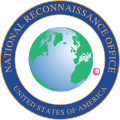History
The name of the program, originally "Rhyolite", was changed to "Aquacade" in 1975 following the disclosure of the codeword "Rhyolite" in the trial of Christopher Boyce and Andrew Lee.
National Reconnaissance Office co-founder Frank W. Lehan was involved in the program.
The Rhyolite/Aquacade satellites, made by TRW, are rumored to have an umbrella-like reflecting dish 20 meters in diameter. They were succeeded by the Magnum/Orion and Mentor series of satellites.
Satellites
During the Cold War, the US intelligence agencies, such as the National Security Agency (NSA), were reportedly able to intercept Soviet microwave traffic using satellites such as Rhyolite/Aquacade. [1] Much of the beam of a microwave link passes the receiving antenna and radiates toward the horizon, into space. By positioning a geosynchronous satellite in the path of the beam, the microwave beam can be received.
The satellites had a mass of approximately 700 kg and operated in near-geosynchronous orbits over the Middle East. Signals were relayed to a remote NSA Earth station in Australia, Pine Gap, out of range of Soviet detection. From there, they would be encrypted and sent via another satellite to the NSA's headquarters at Fort Meade for analysis. [3]
It is believed that at least four Rhyolite/Aquacade satellites were launched from Cape Canaveral Air Force Station LC-13 between June 1970 and April 1978 on Atlas-Agena D launch vehicles, all of which sported distinctive elongated payload shrouds (presumably to house the satellite's large parabolic antenna). Secrecy around the program was tight and the initial Rhyolite mission in 1970 was the first space launch at Cape Canaveral in seven years that reporters were not invited to cover. These were among the final Atlas-Agena launches as well as the last use of LC-13 at CCAS.
Rhyolite Satellites| Names | COSPAR ID | SATCAT No. | Launch date
(UTC) | Launch vehicle | Remarks |
|---|
| Rhyolite 1, [4] OPS 5346, Aquacade 1 [5] | 1970-046A | 04418 | 19 June 1970
11:37 | Atlas SLV-3A Agena-D 5201A | Initially positioned at 105° East [5] (Other sources mention it was left in transfer orbit). [4] |
| Rhyolite 2, [6] OPS 6063, Aquacade 2 [5] | 1973-013A | 06380 | 6 March 1973
09:30 | Atlas SLV-3A Agena-D 5202A | Initially positioned at 70° East [5] |
| Aquacade 3, [5] Rhyolite 3, [7] OPS 4258 | 1977-114A | 10508 | 11 December 1977
22:45:01 | Atlas SLV-3A Agena-D 5504A | Initially positioned at 70° East [5] |
| Aquacade 4, [5] Rhyolite 4, [8] OPS 8790 | 1978-038A | 10787 | 7 April 1978
00:45:01 | Atlas SLV-3A Agena-D 5505A | Initially positioned at 115° East [5] |
The Canyon Satellite Program was a contemporaneous, near-geosynchronous program with closer ties to the United States Air Force.
This page is based on this
Wikipedia article Text is available under the
CC BY-SA 4.0 license; additional terms may apply.
Images, videos and audio are available under their respective licenses.


